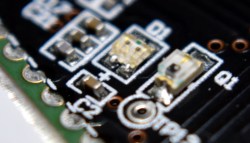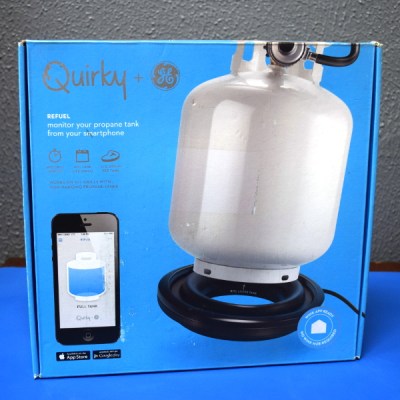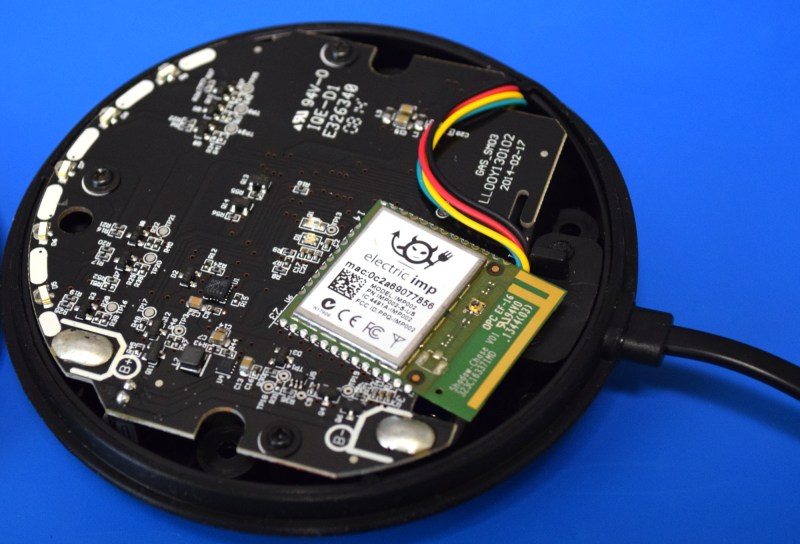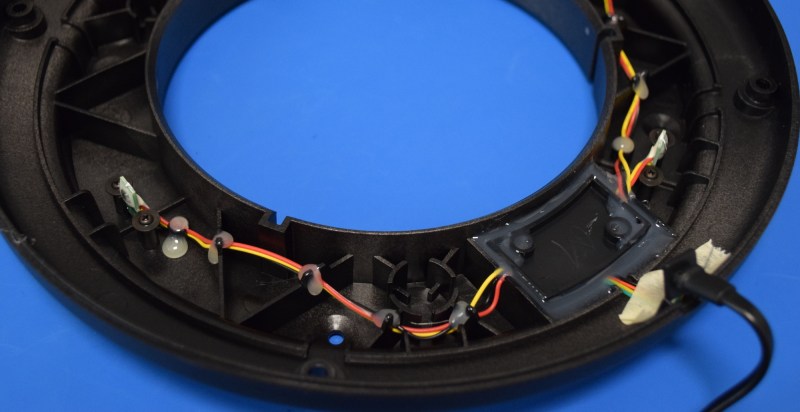Regular Hackaday readers will know that the clearance section of your local big box retailer is a great place to pick up oddball gadgets and gizmos for dirt cheap. In an era where manufacturers are rushing to make their products “smart” whether they need to be or not, the occasional ideas which fail to gain traction are just the cost of doing business. If you keep an eye out, you’re almost guaranteed to see one of these Internet of Things rejects collecting dust on a back aisle, often selling for pennies on the dollar.
Case in point, the “Refuel” propane tank monitor from Wink. Though there’s also logos for Quirky and GE on the package as well, and even a picture of the guy who came up with the idea. Essentially what we have here is a digital scale that reports the current weight of your grill’s propane tank to your phone via the Internet. A trick we might consider a fairly simple hack with a load cell and an ESP8266 under normal circumstances, but as this is a commercial product with an MSRP of $49.99 USD, its naturally been over-complicated to the point of absurdity.
Of course, one could simply lift the propane tank and get a decent estimate of its contents; a trick mastered by weekend grill masters since time immemorial. But then you wouldn’t have to make an account with Wink, or go through the very strange process of attempting to configure the device by using the flashing light of your smartphone’s screen (seriously). All so you can check how much propane is left in your grill while you’re away from home. You know, as one does.
Frankly, it’s hard for me to imagine who would actually have purchased such a thing at full retail. But of course, that’s likely why I was able to pick it up for the princely sum of $5. At that price, we can’t afford not to take a peek into this gizmo from Wink, Quirky, GE, and Anthony from Boston.
Imp Inside
The Refuel consists of two primary components: the scale itself, and the base unit (for lack of a better term) that actually connects it to the WiFi network. The base unit has a magnetic backing which allows the user to stick it to the frame of the grill, and is linked to the scale with about one meter of flat cable that is separated in the middle by a waterproof connector.
Upon opening the device up, we’re greeted with quite a surprise indeed: inside there’s a rather jauntily positioned Electric Imp module. Specifically, the now obsolete (but still available for purchase at the time of this writing) IMP002. Long before the ESP8266 was even a twinkle in the hacker’s eye, these 32bit WiFi-enabled modules promised to be one of the easiest ways to get your hardware projects online. We’ve seen some very impressive builds centering around Electric Imp boards since then, and it’s nice to see first hand that they’ve made inroads in the consumer electronics space.

In hindsight, the screen blinking configuration scheme should have been a huge hint about what was powering this device. This capability is known as “BlinkUp” in Electric Imp parlance, and is advertised as a way for end users to quickly and easily configure their device with their smartphones. It avoids the security implications of setting up a temporary WiFi Access Point the user needs to connect to, but unfortunately can be somewhat finicky as so much depends on the environment.
It’s clear that the IMP002 module is the star of the show here, as the rest of the PCB is nearly bare. Most of the other components are devoted to driving the array of bi-color LEDs on the edge of the board, which are used to show a rough “fuel gauge” on the unit itself so you don’t always have to break out the phone.
A Whale of a Scale
I presumed that the scale portion of the Refuel would be a load cell of some type, and felt especially confident when I saw the four wire cable. The last thing I expected to see inside was a trio of Hall effect sensors, matching spring-mounted magnets, and some mystery electronics.
The three sensors are oriented in a triangle configuration, clearly to get a more accurate read on the tank’s weight. Each Hall effect chip is mounted on a tiny silk screened PCB and has been lovingly encapsulated in epoxy to protect them from the elements. For something that I had assumed was only a step above a novelty gift at first glance, the construction here is really quite impressive.
 All of these sensors are connected to a potted box directly under where the wire from the base unit comes into the scale. Obviously there’s some trickery going on inside of this compartment, and I’ll admit that the prospect of digging through that sealant was almost enough for me to just leave it sealed up, but the readers of Hackaday deserve better than that; we must have answers. So I loaded “lofi hip hop radio – beats to relax/study to” on YouTube and got to work with a sharp blade.
All of these sensors are connected to a potted box directly under where the wire from the base unit comes into the scale. Obviously there’s some trickery going on inside of this compartment, and I’ll admit that the prospect of digging through that sealant was almost enough for me to just leave it sealed up, but the readers of Hackaday deserve better than that; we must have answers. So I loaded “lofi hip hop radio – beats to relax/study to” on YouTube and got to work with a sharp blade.
Inside was a fairly dense little PCB complete with a PIC16F1823 microcontroller. I didn’t pry it out of the shell since it appeared to be glued down pretty well, but just seeing that MCU on there is enough to tell us everything we need to know. The chip is reading the raw data from the three Hall effect sensors, processing it, and sending it up to the Electric Imp digitally. One could argue that the scale isn’t really a sensor so much as an independent piece of equipment which is working in conjunction with the base station.
Heavyweight Communications
So we have four wires connecting the scale to the base station: we know two of them are power, and two of them are data. My first guess was I2C since we’ve seen that in other commercial products which used drop-in wireless modules like this, but turns out it was basic UART. It even seems some of the data is in plain ASCII, though I haven’t quite figured it all out.
Approximately 15 seconds after it’s powered up, the base station sends the character “V” to the PIC16F1823, and receives a reply which appears to be the version number of the scale’s firmware. The base station then makes a dozen sequential requests for data from the scale, presumably some kind of calibration table. After this exchange, normal operations begin.
From this point on, every 1.5 seconds the base station and scale exchange a heartbeat signal (the letter “A”) to verify both of them are alive and kicking. This brief handshake is followed by an unsolicited ten byte packet from the scale which presumably represents the current tank weight. Unfortunately I haven’t quite deciphered how this value works, as this seems like more data than should be required for a scale that only goes up to 20 pounds.

If the protocol was decoded fully, then the electronics in the base station could be swapped out with a standard microcontroller should anyone want the ability to weigh their propane tank remotely without necessarily buying into the Wink ecosystem. It would also be a simple matter to reuse the scale in a different project entirely, though I’m not really sure how many other potential applications there are for this particular measuring device.
Built Like a Steakhouse
 I still don’t think this product is practical. That being said, I’ve got to admit this thing surprised me. I expected an ill-designed piece of hardware that was put together by the lowest bidder, but it ended up being one of the best built products I’ve had the pleasure of dissecting. The phrase “You get what you pay for” generally has a negative connotation, but I think it’s safe to say the Wink Refuel can be added to the short list of gadgets that earned their price tag.
I still don’t think this product is practical. That being said, I’ve got to admit this thing surprised me. I expected an ill-designed piece of hardware that was put together by the lowest bidder, but it ended up being one of the best built products I’ve had the pleasure of dissecting. The phrase “You get what you pay for” generally has a negative connotation, but I think it’s safe to say the Wink Refuel can be added to the short list of gadgets that earned their price tag.
I don’t know if that comes as any consolation for those who spent fifty bucks so they look longingly at how many steaks they could be cooking if it wasn’t for the fact they were stuck at work, but I certainly don’t regret coughing up the $5 to tear it apart.




















The moment I saw “the flashing light of your smartphone’s screen”, I figured it had an Electric Imp in it. I used one of those for my attic squirrel trap monitor.
“All of these sensors are connected to a potted box ”
“Potted” let it weigh your potted plant and signal you if it needs more water (weight) added.
Thumbs up. Plus one. This.
source programmable guidance?
How to calibrate for the incremental weight variation due to foliage growth, seasonal variation and pruning? extremely low frequency fourier transform, perhaps?
I don’t know, but I did consider that to be a problem for long term use.
(that reminds me, I need to water the potted herbs again!)
You could probably calibrate on every cycle based on the phase angle of the changing weight. As it gets closer to being dried out, the weight reduces less. You could probably calculate a growth rate based on the max weights at each cycle and compensate for plant growth.
Better if you have a fill sensor, so it doesn’t need to know how much to add, only detect when it is dry.
Next question: if you found a case of them for $5 each what could you do with them?
That’s an easy one for me to answer!
Hoard them!
(Not until some increase in market value… but until their cardboard boxes rot in the humid garage)
B^(
Sell them on amazon.ca for 122.96 canadian dollars.Go on the show The Dragons!Sell to people with flooded homes so they cane come back when its over.
“You win again, Gravity!”
Great write-up, and thnks for the “Amazon Women in the Mood” reference .. that’s one of my favorite Futurama episodes.
https://youtu.be/uFNN5Qf2AR4
big thing to note: Quirky folded…..their business model was not sustainable even after partnering with GE….There is a new iteration of Quirky but it is not really the same crowdsourcing idea farm that the original one was….
PrimaGaz (A European bottled gas seller) has their own app to check the emptyness of your canister, albeit not remotely*, that I think is far more elegant: One has to strike the canister and the app analizes the sound to determine how much liquid gas is still available: IMHO a much more precise measurement than weighing, as the weight of the pressure regulator and length of hose doesn’t have to be avcounted for. Demo/ad at https://youtu.be/2meiWuP-AHc
* A determined hacker could of course use a solenoid + streaming server to strike the canister remotely and transmit the sound to the app.
Ours has a sticker on the side.
Pour a cup of hot water on it, the line turns blue to show the tank level.
I use a bathroom scale.
mine uses a burner attached to the end of a hose… when the fire goes out you swap the cylinder.
LOL
my grill has a hanger for the propane canister that is spring loaded and has a scale to indicate the aproximate level.
This failed because it was more expensive than just getting a second tank and never actually running out because you replace the empty one with the full one and keep cooking and then the next day you either fill the empty one or trade it in for a new one (depending on how its done in your area, here there is no more filling it is all trade ins.)
No filling? Have you tried calling RV parks or U-Haul corporate locations (if in the US)? The former can tell you where to get a refill, and many of the latter offer them. Amerigas has a map of refill locations on their site, as well. Not exhaustive, but a good place to start.
You must live in a different universe to me. Cylinders in mine only run out when some combination of location and time makes it impossible to obtain a replacement or refill, and always at the start of useage rather than the end.
Not really of any use when you are going home after a shopping trip on a Sat morning thinking I wonder if the bbq tanks are empty …. The bbq is scheduled in an hour… or you ave a country/remote property and you are wondering if to pack a full propane tank prior to leaving town.
On the (more or less remote) property are enough trees to have plenty of firewood all the time. Tha’s much more economic than using propane for the barbeque. :-)
Mine runs on bags of charcoal. They provide great visual feedback.
Last sunday it was already tactile feedback – “oh shit that bag is really light”. But, see above, we just chopped up some wood.
Interesting. I wonder what the maximum weight capacity is? For $5 this would make an awesome beehive monitor although it would have to be able to handle 200-300lbs which is probably a bit much.
put the beehive on a lever
You could use a lever to divide by 10 or alternatively, a counterweight to balance the first 180lbs leaving you with a 20lb honey scale
Just hack a cheap bathroom scale or Wii Fit.
Regardind the wii fit, does anybody know how to make the ESP32 cxommunicate with the wii fit. The wii use classic bluetooth (not ble) but the ESP32 (arduino IDE) doesn’t have any example to get’s me going on this subject. Suggestions anyone?
Archimedes!
give me a lever and a place to put it or I’ll execute a hostage every hour on the hour!
LOL!
(that’s twice! Thank you!)
The better version of this uses ultrasonics to measure the volume of propane inside the tank. Would be interested to see a teardown/analysis of it: http://mopeka.com/products/
There is a much more practical device called the Mopeka Tank Check, which I use in my RV and might buy for my gas grill. See https://mopeka.com/ . The pocket-sized sensor attaches to the bottom of the tank using two strong magnets, and couples an ultrasonic SONAR sensor to the tank which is just a small piezoelectric emitter/receiver. It then measures the height of liquid in the tank. It comes with a nice wireless panel with LED readouts (for standard height tanks only), and you can also use it with Bluetooth LE on your phone (for tanks of any height). They have sensors for 100 lb, so you can use this for the big home LPG tanks. They also have a cloud gateway for the large tanks, so you can check a large tank’s fill remotely.
Anyone know what logic analyzer those screen shots were captured from?
PulseView
https://sigrok.org/wiki/PulseView
wow, all that just to make sure you’re not left with uncooked food because the tank went empty… Easy solution is a 2nd and much smaller tank which is also refillable. And they already make them. 4.5/5lbs tanks have the same hose fitting and are refillable. So just run your 15 lbs tank empty, a quick swap to the small tank to finish your meal and then take both to be filled and you’re ready to go for a couple of months again. The small tank makes for a great camping option too.
I would argue an easier solution would be to get a $10 analog gauge from a hardware store.
Why not two big tanks? At least here in Germany a small 5kg or the puny 3kg cylinder costs almost the same as the standard 11kg cylinder for deposit and refill. If you have a spare 5kg cylinder or a spare 11kg cylinder in your garage makes no difference.
Just my opinion, no pun intended.
The baby tanks actually cost significantly more in the US. 20-pound bottles are cheapest, both in terms of unit cost and price per pound.
I don’t know how small tanks work out with cylinder exchanges since I’ve never seen a small tank exchange. I wouldn’t expect it to be great, seeing as exchanges are a colossal rip-off anyway.
Austria: Exchange for a ~3kg butane tank was over 30€ :-( So yes, small tanks are a rip off.
“It’s alright, it’s alright, it’s alright…
…propane!”
-Eric Clapton
That’s what I think every time I hear that song. Unless someone is talking about Spokane, WA.
I use a fish scale, I measured a full tank and an empty one, put electrical tape on the “full” and the “empty” weights and just lift the tank with it. Mighty Flame and Blue Rhino tanks are a little different, but it’s close enough. I bought the scale originally to calibrate tension in Zebra high speed printers, so the $15 has long ago been absorbed.
Normally the container weight is printed/stamped on to the tank. (Tara)
Tare. Tara was the plantation in Gone With the Wind.
Sorry, not to know that difference between English and German language or “Gone With the Wind”
“As God is my witness, I will never use propane again!”
Okay… but which “big box retailer” did you find it at for $5?!?
You can probably find them at Ollie’s or Big Lots in the USA.
Cleaning your grill once with a wire brush would make these particular scales only read “full tank” from that point forward. The scale portion of the device isn’t sealed and the neodymium magnets actuating the hall effect sensors would attract any of the ferrous metal dust raining down on the scale while the grill rack was being scrubbed with a wire brush. The hall effect sensors would then sense a weaker magnetic field from the metal dust coated magnets and assume the magnets were farther away. Unfortunately if a customer cleaned their grill top once the app would display “4/4” tank full from then on.
My solution to this problem was to plumb my barbeque into town gas.
I had the builder put an outlet on my balcony and got a barbeque that had the correctly sized jets.
No running to the store and lugging heavy bottles up and down the stairs halfway through cooking a steak for me.
Love it!
I love how it needs bibble to send data to babble which uses the booble framework, dependant on the frabble architecture, which is built on the droble backend, and uses a frooble to process data so puffle can interact with druffle to fluffle the socksifier.
All these useless frameworks seem to want to exfiltrate your data. A digital scale should not need permissions to access my contacts, manage my phone calls, see my files, etc.
Whatever happened to bluetooth serial?
this app probably weighs in [haha , get it?] at 50Mb or so, and probably sends data to dozens of services and servers. One goes down, and the whole app is junk.
in sweden basically all customer gas bottles for RV and BBQ are made from transparent composite fiber- you see how much gas is left.
Two practical uses for a remote scale: Heating a henhouse or greenhouse
Thanks, man! We worked hard on this thing… ill conceived or not.
I think you guys missed your market. All the HVAC technicians out there are like “WOW, a device that lets me measure my freon bottle with my phone that doesn’t cost me $300!”.
A simple scale does not cost 300.
Starting to learn just how goddamned absurd I once was, the slowly dying elitist city-boy in me still laughing alongside this guy’s ideas of a bbq-notifier, yet presently sitting in a home where such a device might prevent waking and/or returning to a house full of propane-‘poo’ odor… a heating system that may require professional inspection, or worse, an asphyxiated pet.
If you have larger amounts of propane accumulating in the house, the “poo” odor or even the dead pet might be your least problem. The big bang, the big hole in the wall and the roof flying away could be just one spark away.
Campers who heat their trailers with liquid propane would use this as it’s inconvenient to run out of heat in the middle of the night.